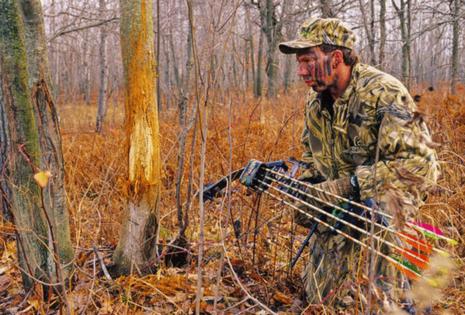The epic archery hunt at Minnesota's Camp Ripley was an annual party. Here's why it's never coming back.
Published in Outdoors
MINNEAPOLIS — For four decades, Minnesota’s annual weekend deer hunts at Camp Ripley in Little Falls were considered the largest gatherings of archery hunters in North America.
Twice a season, the gates would open for 1,800 to 2,400 hunters to fan out across the installation’s 53,000 acres in pursuit of wild whitetails. Most dreamed of arrowing a trophy buck, but they also relished the camaraderie of overnight camping on the post’s perimeter.
There, amid tents and trailers jammed together along Camp Ripley’s surrounding roadsides, libations were shared, cameras clicked, faraway friends reunited, new friendships formed and tales were told of monster bucks.
“There was the perception (Ripley) was filled with big bruisers,” said Beau Liddell, who ran the hunt for many years as the area wildlife manager for the state Department of Natural Resources. “The way the hunters treated it, it was a rat race.”
Starting this season, the free-for-all is over and there’s no talk of bringing it back.
Liddell said military officials adopted a radically different format this season that opened the range to archery hunting on most days of Minnesota’s deer season — but capped participation at 150 individuals a day.
“It was a super-huge logistical challenge and we’d have to shut down all military training,” Jake Kitzmann, Camp Ripley’s natural resources manager, said about the old system. The post is operated by the Minnesota National Guard.
“The steady trickle is much, much easier to manage,” Kitzmann said.
Gone is the once-a-year, three-day hunt that drew deer hunters from far and near because they were certain to gain entry. The three-day hunt was a replacement for the previous format of two two-day weekend hunts, also open to as many bow hunters who showed up. The theory espoused by managers of the hunt was that the placement of so many hunters in the woods at once would trigger more movement within the camp’s deer herd, leading to more shooting opportunities.
Kitzmann said feedback on the new system has been mixed, but the majority of responses have been “quite positive.” The people who like it say it’s more of a natural hunt with the added convenience of choosing your own field days. Others miss the festive roadside camping and they fear seeing fewer deer while afield.
Lindy Frasl, an avid bow hunter from the Brainerd area, said he and his brother, Greg Kretzman, have participated in the Camp Ripley archery deer hunt since its inception. They miss the night-time card games, reunions and levity of the “rat-race” era, but the new format gives them much more access to the wild, public land that they cherish. Camp Ripley is 17 miles long by seven miles wide, has its own timber wolf population, provides varied terrain and is free of hunting rifles and shotguns during the firearms season.
“Doing it this way is way more beneficial to us,” Frasl said. “It’s amazing we can come in here any day we want. … There’s just something about Camp Ripley.”
Kitzmann said he expects participation in the new hunt to increase as people get more accustomed to the online permitting system. Learning the system is a turnoff to some hunters and a chief complaint is that you can’t obtain a permit until 12:01 a.m. on the day you choose to hunt. As soon as 150 permits are issued (sometimes within 10 minutes), registration closes for the day.
People who live far away say the late-night registration is a deal-breaker because they’d have to drive in the middle of the night if they want to arrive for the 6 a.m. opening.
Various hunters have voiced their likes and dislikes with the new system on the “Unofficial Camp Ripley Archery Hunt” Facebook page. One commenter put it this way: “Not a fan! I personally enjoyed camping out there, and the camaraderie between other hunters. Did it get annoying sometimes? Yes. But to me that was part of the challenge of bagging a good deer out there. Now I have to sit online and apply for a possible chance to even go, when before you were almost guaranteed a permit.”
Kitzmann said the largest demand for permits occurred this year during the last week of October and first week of November. Those sellouts were anticipated because they coincided with the whitetail “rut,” or mating season, when bucks are most vulnerable.
But during most weeks of this year’s archery season, including some Saturdays and Sundays, plenty of permits go unused, he said. Even during the opening weekend of the firearms season, when Camp Ripley was expected to be sold out for bow hunters, usage was below capacity.
Josh Pennington, conservation programs supervisor at Camp Ripley, said officials will consider expanding the daily participation cap next year beyond 150 hunters to allow more prime-time opportunities.
For now, he said, the Camp Ripley archery hunt is likely to fall short of past harvests. As of last Tuesday, the camp had issued 1,600 permits. The harvest stood at 125 deer.
Kitzmann said the camp is accustomed to seeing an average of 280 harvested per season. “If we get back to that range, I’ll be happy with it all,” he said.
But Frasl, Kretzman and other Camp Ripley regulars are hoping for a sustained decline in overall harvest to pump up the herd. They’ve been seeing fewer deer and they sense a decline in the herd’s age structure — meaning there’s not as many mature bucks available for harvest. What they’d like to see is for the DNR or Camp Ripley to restrict the harvest to one deer per hunter. Currently, hunters in the area can harvest one buck and one antlerless deer.
Pennington said resource managers don’t see it that way. They haven’t detected a drop-off in the camp’s deer population and are considering expanding hunting opportunities. Controlling the size of the herd is important to avoid over-population that would interfere with the military’s use of the facility, he said.
“From a hunter’s perspective, who doesn’t want more deer on the landscape?’’ Pennington said.
©2024 The Minnesota Star Tribune. Visit startribune.com. Distributed by Tribune Content Agency, LLC







Comments